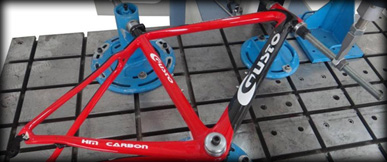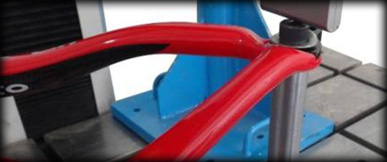To assure product performance and safety, Gusto set up a Bicycle Safety Inspection Laboratory. The lab is equipped with test machines that are in accordance with the latest EU standard EN test specifications. This includes different set ups for the different testing standards: 3 types of fatigue tests, 2 type of impact tests, and 3 type of rigidity tests.
GUSTO guarantees the safety of its bicycles for 100%. We pursue the same level of quality and customer satisfaction.
Seat post fatigue test
Purpose: To test for damage after riding the seat post with vibration. If there is any peeling of the paint, scratches, or breaking during and after the test completed, the part is not allowed in a Gusto frame. Cushion components cannot be detached.

Head tube fatigue test
Purpose: To test for damage in the head tube because of riding. If there is any peeling of the paint, scratches, or breaks during and after the test is completed, the part is not allowed in Gusto

BB fatigue test
Purpose: To test for damage in the BB because of riding riding. . If there is any peeling of the paint, scratches, or breaks during and after the test is completed, the part is not allowed in Gusto frame. Cushion components cannot be detached.

Frame impact test
Purpose: To test for damage after getting impact from riding. Damage in bike frame is not allowed during and after the test.

Rigidity test
A bike frame with poor stiffness will influence the riding efficiency due to deformation of the frame. The following 3 rigidity tests are passed to assure good acceleration of the bike frame.

BB rigidity test
The degree of deformation of the BB in riding.

Head tube rigidity test
The degree of deformation degree of the head tube in riding.

Drop-out rigidity test
The degree of deformation of the drop-outs in riding.



